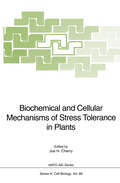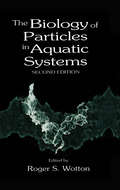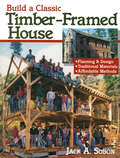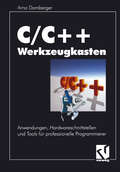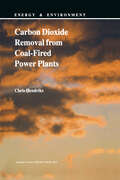- Table View
- List View
Bewertung von Rechnerinvestitionen durch den Vergleich von Wertschöpfungsketten (IPA-IAO - Forschung und Praxis #195)
by Christian F. MayerBiochemical and Cellular Mechanisms of Stress Tolerance in Plants (Nato ASI Subseries H: #86)
by Joe H. CherryEnvironmental stresses, such as high and low temperature, salinity, and drought, represent limiting factors to agricultural productivity worldwide. Their impact is not only on crops that are presently being cultivated, but they are also significant barriers to the introduction of crop plants into noncultivated areas. The book describes the cellular, biochemical, and molecular mechanisms in plants that regulate tolerance to stresses. Also discussed are prospects of engineering stress-tolerant plants through the modification of germplasm.
Biodiversity and Ecosystem Function (Springer Study Edition Ser.)
by Ernst-Detlef Schulze Harold A. MooneyThe biota of the earth is being altered at an unprecedented rate. We are witnessing wholesale exchanges of organisms among geographic areas that were once totally biologically isolated. We are seeing massive changes in landscape use that are creating even more abundant succes sional patches, reductions in population sizes, and in the worst cases, losses of species. There are many reasons for concern about these trends. One is that we unfortunately do not know in detail the conse quences of these massive alterations in terms of how the biosphere as a whole operates or even, for that matter, the functioning of localized ecosystems. We do know that the biosphere interacts strongly with the atmospheric composition, contributing to potential climate change. We also know that changes in vegetative cover greatly influence the hydrology and biochemistry ofa site or region. Our knowledge is weak in important details, however. How are the many services that ecosystems provide to humanity altered by modifications of ecosystem composition? Stated in another way, what is the role of individual species in ecosystem function? We are observing the selective as well as wholesale alteration in the composition of ecosystems. Do these alterations matter in respect to how ecosystems operate and provide services? This book represents the initial probing of this central ques tion. It will be followed by other volumes in this series examining in depth the functional role of biodiversity in various ecosystems of the world.
Biological Microtechnique
by Jeremy SandersonA completely new practical guide to both new and classical methods of slide-making which is easy-to-read and easy-to-understand. Biological Microtechnique contains a wealth of practical detail which will provide a firm grounding in preparative methods for light microscopy.
Biological Microtechnique
by Jeremy SandersonA completely new practical guide to both new and classical methods of slide-making which is easy-to-read and easy-to-understand. Biological Microtechnique contains a wealth of practical detail which will provide a firm grounding in preparative methods for light microscopy.
The Biology of Particles in Aquatic Systems, Second Edition
by Roger S. WottonThe Biology of Particles in Aquatic Systems, Second Edition presents the latest information on particulate and dissolved matter found in aquatic habitats ranging from small streams to oceans. Only by studying this matter can we gain an understanding of the functioning of aquatic ecosystems and thus be able to predict changes that may occur as these systems become stressed. Updated and extensively revised, this new edition covers such topics as classification of particulate and dissolved matter, origin and formation of particles aquatic systems, factors affecting particle aggregation, methods for capturing particles by benthic and planktonic animals, and the use of particulate and dissolved organic matter as food.
The Biology of Particles in Aquatic Systems, Second Edition
by Roger S. WottonThe Biology of Particles in Aquatic Systems, Second Edition presents the latest information on particulate and dissolved matter found in aquatic habitats ranging from small streams to oceans. Only by studying this matter can we gain an understanding of the functioning of aquatic ecosystems and thus be able to predict changes that may occur as these systems become stressed. Updated and extensively revised, this new edition covers such topics as classification of particulate and dissolved matter, origin and formation of particles aquatic systems, factors affecting particle aggregation, methods for capturing particles by benthic and planktonic animals, and the use of particulate and dissolved organic matter as food.
Biomagnetic Stimulation: Principles And Applications Of Biomagnetic Stimulation And Imaging
by Shoogo UenoThe International Symposium on Biomagnetic Stimulation was held on July 15, 1991 at the International Hall of the Hakozaki campus of Kyushu University in Fukuoka, Japan. It was a satellite symposium to the World Congress on Medical Physics and Biomedical Engi neering in Kyoto, which was held July 7-11, 1991. Successful magnetic stimulation of the human brain was first reported by Dr. Anthony Barker and his group at the University of Sheffield in the United Kingdom, in May, 1985. Of course, magnetic nerve stimulation had been studied and reported before then, but Dr. of successful stimulation of the brain made a strong impact on the scientific Barker's reports community. Since then, magnetic nerve stimulation has been widely and rapidly investigated by many groups throughout the world. This symposium focused mostly on magnetic brain stimulation. Magnetic resonance imaging has become an indispensable technique for clinical diagno sis and medical science. The most advanced MRI techniques, such as echo planar imaging, have the potential hazard of stimulating nerve tissues due to the rapid change of gradient mag netic fields. Potential risks of MRI, including problems with gradient magnetic fields, were discussed at the symposium. Magnetic stimulation of the heart was also discussed.
Biomaterials, Medical Devices and Tissue Engineering: An integrated approach
by F.H. Silverare then selected and must meet the general 'biocompatibility' require ments. Prototypes are built and tested to include biocompatibility evalua tions based on ASTM standard procedures. The device is validated for sterility and freedom from pyrogens before it can be tested on animals or humans. Medical devices are classified as class I, II or III depending on their invasiveness. Class I devices can be marketed by submitting notification to the FDA. Class II and III devices require either that they show equivalence to a device marketed prior to 1976 or that they receive pre-marketing approval. The time from device conception to FDA approval can range from months (class I device) to in excess of ten years (class III device). Therefore, much planning is necessary to pick the best regulatory approach. 2. Wound Dressings and Skin Replacement 2.1 Introduction Wounds to the skin are encountered every day. Minor skin wounds cause some pain, but these wounds will heal by themselves in time. Even though many minor wounds heal effectively without scarring in the absence of treatment, they heal more rapidly if they are kept clean and moist. Devices such as Band-Aids are used to assist in wound healing. For deeper wounds, a variety of wound dressings have been developed including cell cultured artificial skin. These materials are intended to promote healing of skin damaged or removed as a result of skin grafting, ulceration, burns, cancer excision or mechanical trauma.
Biotechnology and Bioactive Polymers
by Charles E. Carraher Jr. C. G. GebeleinSome have predicted that the coming several decades will be the decades of "biotechnology," wherein cancer, birth defects, life span increases, cosmetics, biodegradation, oil spills and exploration, solid waste disposal, and almost every aspect of our material life will be affected by this new area of science. There will also be an extension of emphasis on giant molecules: DNA, enzymes, polysaccharides, lignins, proteins, hemoglobin, and many others. Biotechnology has been defined in various ways. In one sense, this field is older than human history and references to the human use of biotechnology-derived materials can be found in the oldest human writings, such as the Bible. In this book, biotechnology refers to the direct usage of naturally occurring materials or their uses as a feedstock, including the associated biological activities and applications of these materials. Bioactive polymers, on the other hand, are polymers which exert some type of activity on living organisms. These polymers are used in agriculture, controlled release systems, medicine and many other areas. The papers in this book describe polymers which essentially combine features of biotechnology and bioactivity.
The Boundary Element Method (Solid Mechanics and Its Applications #27)
by W.S. HallThe Boundary Element Method is a simple, efficient and cost effective computational technique which provides numerical solutions - for objects of any shap- for a wide range of scientific and engineering problems. In dealing with the development of the mathematics of the Boundary Element Method the aim has been at every stage, only to present new material when sufficient experience and practice of simpler material has been gained. Since the usual background of many readers will be of differential equations, the connection of differential equations with integral equations is explained in Chapter 1, together with analytical and numerical methods of solution. This information on integral equations provides a base for the work of subsequent chapters. The mathematical formulation of boundary integral equations for potential problems - derived from the more familiar Laplace partial differential equation which governs many important physical problems - is set out in Chapter 2. It should be noted here that this initial formulation of the boundary integral equations reduces the dimensionality of the problem. In the key Chapter 3, the essentials of the Boundary Element Method are presented. This first presentation of the Boundary Element Method is in its simplest and most approachable form - two dimensional, with the shape of the boundary approximated by straight lines and the functions approximated by constants over each of the straight lines.
Build a Classic Timber-Framed House: Planning & Design/Traditional Materials/Affordable Methods
by Jack A. SobonBuild a classic, enduring, and affordable home. With Jack A. Sobon&’s careful guidance, you can construct your own timber-framed house in the traditional hall-and-parlor style. From felling trees to cutting timbers, and frame construction to door selection, you&’ll find Sobon&’s professional advice and hand-drawn illustrations invaluable. Whether you&’re a first-time builder or a seasoned contractor looking to expand your repertoire, you&’ll find answers to all your timber-frame questions. Open the front door and walk into the home of your dreams.
Building Services and Equipment: Volume 1
by F. HallServices and equipment in complex modern buildings account for over one-third of the total cost. Therefore study of services and equipment is essential for technicians in construction, surveying and architecture.Building Services and Equipment Volume 1 is the first book in a widely acclaimed trilogy that has become established as the leading work in this field. This volume deals with the topics of fuel conservation and thermal comfort by use of integrated heating, ventilating, air conditioning and lighting systems, district heating, thermal insulation, heat pumps and thermostatic controls.
Building Services and Equipment: Volume 1
by F. HallServices and equipment in complex modern buildings account for over one-third of the total cost. Therefore study of services and equipment is essential for technicians in construction, surveying and architecture.Building Services and Equipment Volume 1 is the first book in a widely acclaimed trilogy that has become established as the leading work in this field. This volume deals with the topics of fuel conservation and thermal comfort by use of integrated heating, ventilating, air conditioning and lighting systems, district heating, thermal insulation, heat pumps and thermostatic controls.
Building Services and Equipment: Volume 3
by F. HallA widely acclaimed trilogy that has become established as the leading work in this field. As well as taking account of current Building Regulations, Codes of Practice and recent technological advances. Special attention has been paid to the reduction of fuel costs and environmental factors.This volume covers the essential design calculations for pipe-sizing, drainage, electrical installations, thermal problems, ventillation and air conditioning, gas installations, lighting and solar heating.
Building Services and Equipment: Volume 2
by Frederick E HallA widely acclaimed trilogy that has become established as the leading work in this field as well as taking account of current Building Regulations, Codes of Practice and recent technological advances. Special attention has been paid to the reduction of fuel costs and environmental factors.This volume covers pipe-sizing for hot and cold water installations, fine control systems, fire detactor systems, lifts and escalators, service ducts, burglar alarms, gas and electricity supply, daylighting and artificial light
Building Services and Equipment: Volume 2
by Frederick E HallA widely acclaimed trilogy that has become established as the leading work in this field as well as taking account of current Building Regulations, Codes of Practice and recent technological advances. Special attention has been paid to the reduction of fuel costs and environmental factors.This volume covers pipe-sizing for hot and cold water installations, fine control systems, fire detactor systems, lifts and escalators, service ducts, burglar alarms, gas and electricity supply, daylighting and artificial light
Building Services and Equipment: Volume 3
by F. HallA widely acclaimed trilogy that has become established as the leading work in this field. As well as taking account of current Building Regulations, Codes of Practice and recent technological advances. Special attention has been paid to the reduction of fuel costs and environmental factors.This volume covers the essential design calculations for pipe-sizing, drainage, electrical installations, thermal problems, ventillation and air conditioning, gas installations, lighting and solar heating.
Business Process Engineering: Reference Models for Industrial Enterprises
by August-Wilhelm ScheerThe first English-language edition of this book was published in 1989 under the title "Enterprise-Wide Data Modelling." It introduced a new enterprise data model that has since gone on to enjoy widespread use as a reference model. Since that time, the author has continued to develop the representation of application problems, both on a theoretical basis using modeling languages and on a practical basis using real-world studies. This has led to so many new aspects that this second English-language edition (the original German version is now in its fifth edition) constitutes a completely new book. The new title expresses the stricter emphasis on business processes in contrast to the previous edition, which was geared more toward a functional structure. This approach reflects the trend toward process oriented structural and procedural organization in enterprises that is currently being supported by new means of information processing. Perhaps the most obvious way in which the second English-language edition differs from the first is in the increased number of pages. This is a direct result of the higher degree of detail and the more thorough problem description presented in the new edition. The degree of detail has increased in the case of those problems that are particularly important in terms of selecting and designing information systems in an industrial enterprise, e.g., the product description and CAM factory organization. This approach provides greater reality and thus facilitates a better understanding of the complex organism that is an industrial enterprise.
C/C++ Werkzeugkasten: Anwendungen, Hardwareschnittstellen und Tools für professionelle Programmierer
by Arno DambergerDieses Buch liefert das erforderliche Know-how zur Programmierung von modernen Personal-Computern und peripheren Geräten auf Maschinenebene, um somit professionelle Applikationen erstellen zu können. Neben der Softwareschnittstelle zu allen PC-Hardwarekomponenten werden auch brandaktuelle Themen, wie Sprachausgabe und Grafikbearbeitung in vollem Umfang erläutert. Die vorgestellten Programme werden auf Modulebene ausführlich dokumentiert und mit Ablaufdiagrammen illustriert. Besonderen Wert legt das Buch auf die objektorientierte Realisierung von Anwendungen, so daß dem Leser vielfach die OOP-Varianten herkömmlicher C-Programme vorgestellt werden. Als besonderes Highlight liegt dem Buch ein komplettes PC-Spiel im Grafikmodus bei, dessen Quellcode vollständig offengelegt ist. Zahlreiche der im Buch vorgestellten Routinen finden innerhalb dieser Anwendung Berücksichtigung, so daß der Leser die "Mächtigkeit" dieser Routinen in einer konkreten Anwendung überprüfen kann.
CAD/CAM für Ingenieure: Hardware, Software, Strategien (Studium Technik)
by Sándor Vajna Christian Weber Jürgen Schlingensiepen Dietrich SchlottmannDieses Buch vermittelt dem Studierenden systemneutrale Kenntnisse von CAD-/CAM-Systemen, wie sie heute im Studium vermittelt werden. Im Vordergrund stehen dabei weniger Marktübersichten oder theoretische Grundlagen, als vielmehr Kenntnisse, wie sie von Führungskräften benötigt werden.
Cad Frameworks: Principles and Architecture (The Springer International Series in Engineering and Computer Science #288)
by Pieter van der WolfSince the early 1980s, CAD frameworks have received a great deal of attention, both in the research community and in the commercial arena. It is generally agreed that CAD framework technology promises much: advanced CAD frameworks can turn collections of individual tools into effective and user-friendly design environments. But how can this promise be fulfilled? CAD Frameworks: Principles and Architecture describes the design and construction of CAD frameworks. It presents principles for building integrated design environments and shows how a CAD framework can be based on these principles. It derives the architecture of a CAD framework in a systematic way, using well-defined primitives for representation. This architecture defines how the many different framework sub-topics, ranging from concurrency control to design flow management, relate to each other and come together into an overall system. The origin of this work is the research and development performed in the context of the Nelsis CAD Framework, which has been a working system for well over eight years, gaining functionality while evolving from one release to the next. The principles and concepts presented in this book have been field-tested in the Nelsis CAD Framework. CAD Frameworks: Principles and Architecture is primarily intended for EDA professionals, both in industry and in academia, but is also valuable outside the domain of electronic design. Many of the principles and concepts presented are also applicable to other design-oriented application domains, such as mechanical design or computer-aided software engineering (CASE). It is thus a valuable reference for all those involved in computer-aided design.
Carbon Dioxide Removal from Coal-Fired Power Plants (Energy & Environment #1)
by C. Hendriks1. 1. Greenhouse gas emissions and climate change . . . . . . . . . . . . . . 3 1. 1. 1. Emissions and concentrations of greenhouse gases 3 1. 1. 2. Impact of increasing greenhouse gases concentration 4 1. 2. Options to reduce carbon dioxide emissions 5 1. 2. 1. Carbon dioxide removal 8 1. 3. Scope of the thesis 10 1. 4. Outline of the thesis. . . . . . . . . . . . . . . . . . . . . . . . . . . . . . . . . 11 1. 4. 1. General evaluation method. . . . . . . . . . . . . . . . . . . . . . . 12 1. 4. 2. Some notes . . . . . . . . . . . . . . . . . . . . . . . . . . . . . . . . . . . 13 II. Simulation and optimization of carbon dioxide recovery from the flue gases of a coal-fired power plant using amines 14 Abstract 19 2. 1. Introduction . . . . . . . . . . . . . . . . . . . . . . . . . . . . . . . . . . . . . . . 20 2. 2. The chemical absorption process. . . . . . . . . . . . . . . . . . . . . . . . 22 2. 2. 1. General process description. . . . . . . . . . . . . . . . . . . . . . . 22 2. 2. 2. Types of absorbent 23 2. 2. 3. Effects of flue gas contaminants 24 2. 3. Simulation of the scrubber in ASPEN PLUS . . . . . . . . . . . . . . . . . 25 2. 3. 1. ASPEN PLUS for flow sheet simulation 26 2. 3. 2. Simulation of the performance for the base-case design . . 26 the scrubber . . . . . . . . . . . . . . . . . . . . . . 29 2. 3. 3. Optimization of 2. 3. 4. Design and results 32 2. 3. 5. Discussion. . . . . . . . . . . . . . . . . . . . . . . . . . . . . . . . . . . . 34 2. 4. Integration of the scrubber in the power plant 35 2. 4. 1. Power loss caused by steam extraction 36 2. 4. 2. Power saved by avoiding preheating boiler feed water . . . 38 2. 4. 3. Power consumption by the carbon dioxide scrubber . . . . . 38 2. 4. 4. Power consumption for carbon dioxide compression . . . . . 38 2. 4. 5. Calculation of plant efficiency losses " . . . . . . . . . . . . . . 39 2. 5.

